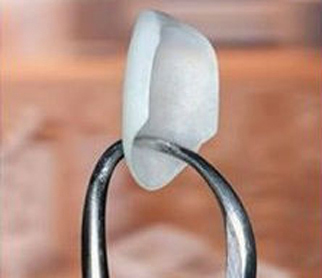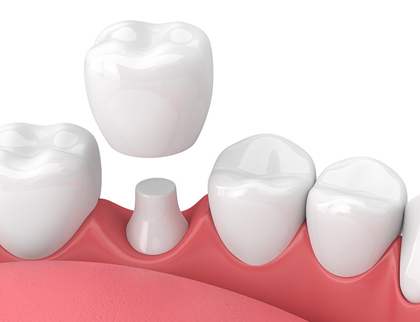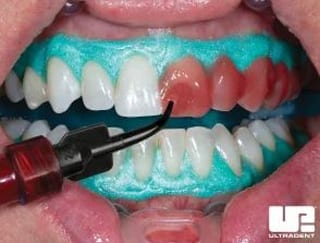Why is my dentist pushing veneers for the gap between my front teeth?
I’ve always loved the gap between my front teeth. And people compliment me on my smile. But as I age, the gap is getting wider. I think that within the next two years, it will be large enough for another tooth to fit in the space. During my dental cleaning a year ago, I talked to my dentist about the gap, and she recommended porcelain veneers. We talked about the cost, and I explained that I’m not interested in paying that much money for my smile when my teeth are otherwise happy. I asked about my options, and she mentioned bonding but quickly added that I would not like the results. So during my cleaning appointment last month, my dentist asked me if I know when I want veneers. I quickly said, “No,” because I do not like confrontation, especially when paying for a service. So, I decided to find a dentist to write to and ask about this situation without any pressure. Why is my dentist promoting porcelain veneers for a tooth gap? Do I really not have any other options? Thank you. – Celina from PA
Celina,
We are glad that you decided to ask another dentist’s opinion. We are unsure why your dentist recommends porcelain veneers only for your gap. Ultimately, you may need an in-person exam with a nearby cosmetic dentist, but we can explain possible options. Please keep in mind that Dr. Goebel would need to examine your teeth for accurate diagnosis and treatment options.
Cosmetic Dentistry Options for a Gap Between Your Teeth
If you have a gap between your teeth, cosmetic dentistry options include orthodontic treatment, porcelain veneers, and dental bonding. We will discuss what to expect with each treatment option.
Correcting a Gap with Braces
Braces will align your teeth and remove the gap between them. If your excess tissue between your front teeth causes the gap, your dentist will need to remove the tissue before receiving braces.
- Treatment time – Average treatment time is six to 12 months
- Cost – Braces cost more than dental bonding. But depending on how many porcelain veneers you need, braces can cost slightly less than veneers.
- How long will it last? – The results are permanent if you wear a retainer.
Correcting a Gap with Porcelain Veneers

Porcelain mimics natural tooth color and gloss. But a dentist must shave a tiny amount of tooth enamel from the fronts of our teeth to ensure the veneers fit well. Depending on the size of your gap, you may need veneers on more than your two front teeth to even out your smile.
- Treatment time – You can receive porcelain veneers in an average of two to three visits. Some cases take longer.
- Cost – Veneers cost more than dental bonding. And they can cost more than braces depending on your case. A single veneer costs about $1,500.
- How long will they last? – High-quality veneers can last ten to twenty years if you take care of them.
Correcting a Gap with Dental Bonding
A skilled cosmetic dentist has an extensive supply of bonding materials and tools to close the gap between your teeth. The dentist blends shades of composite to match your teeth and hide the gap perfectly. And the dentist will polish your teeth to a gloss.
- Treatment time – A highly skilled cosmetic dentist will close the gap with bonding while you sit in the dental chair. It takes about an hour.
- Cost – Bonding is less expensive than braces or porcelain veneers.
- How long will dental bonding last? – High-quality dental bonding can last about five years or longer if you take care of it.
Schedule a Cosmetic Dentistry Consultation
If you schedule a consultation with a cosmetic dentist, they can explain the results you can expect with braces, porcelain veneers, or dental bonding. You will also get specific information on the costs. Check dentist’s websites for information about their cosmetic dentistry training. And check out their smile gallery.
Dr. Thomas J. Goebel, a cosmetic dentist in Moline, IL, sponsors this post. Looking for a cosmetic dentist near you? Read Dr. Goebel’s continuing education.
My tooth is turning dark, but my dentist is not concerned
My right incisor is turning dark, but my dentist is not concerned about doing anything to it. She says that it is not that bad. I have a small smiling in the corner of the tooth to replace a chipped-off piece. But I was 17 years old when it happened. Now, I am 47, and the tooth is getting darker. My dentist said the tooth is dead, and the canal is calcified, so it is too risky to do a crown. And she said that I would not be happy with a veneer, and it costs too much anyway. She suggests that I do nothing unless it becomes very noticeable. But it is noticeable and getting darker. What are my options? Thank you. Trevor
Trevor,
Your description sounds like your dentist is uncomfortable with cosmetic dentistry procedures. We recommend that you not ask your dentist to provide treatment that she is not comfortable completing. Many patients who insist on treatment are unhappy with the results.
Cosmetic Dentistry Options for a Dark Tooth

A porcelain veneer or direct dental bonding are treatment options for a dark tooth. But a dental crown requires aggressive preparation—grinding your tooth to a stub. And usually, a crown is not necessary for correcting tooth color.
- Porcelain veneer – A dentist with advanced cosmetic dentistry training works with a skilled ceramist at a lab to custom craft a veneer. The veneer will match the shape and size of your dark tooth, but the color will match your other teeth. If you want your teeth whitened, do it before you get a veneer.
- Direct dental bonding – While you sit in a dental chair, a cosmetic dentist can mix shades of dental composite to match your surrounding teeth. The dentist will apply, shape, and harden the bonding, then polish it to a natural gloss.
Schedule a Consultation with a Cosmetic Dentist
Although only one tooth is dark, a dentist who does not understand cosmetic dentistry can make your tooth look worse. So look for cosmetic dentists in your area. And examine patient cases in their website smile gallery. If a dentist does not have a website or smile gallery, perhaps they do not have any beautiful work to show. But read online reviews, too, before you schedule a consultation.
You can do something about your dark incisor tooth. And a cosmetic dentist can correct it with a porcelain veneer or dental bonding. Best wishes for a beautiful restoration.
Timothy J. Goebel, DDS, a Moline, IL dentist, sponsors this post.
My dentist can’t match bonding to my whitened teeth
I decided to get Zoom whitening before dental bonding because my teeth were dull. I needed the bonding because I had sensitivity near my gumline. So my dentist completed Zoom, and we waited to see if my teeth were white enough, then she did a repeat office treatment. I loved the whiteness of my teeth, and I got compliments on my smile. I thought I was ready for bonding until my dentist finished it. Now my teeth look pasty and rough. My dentist failed to tell me that she didn’t know how to match the bonding to my whitened teeth. So I am going to find another dentist to redo the bonding. But I would like to know if a dentist must remove the current bonding. Or can they add new bonding on top of it? – Thanks. Chase from IN
Chase,
We are sorry to hear about the disappointment with your bonding after you completed Zoom whitening.
If a dentist has cosmetic dentistry training, it should not be difficult to match the color and texture of your teeth. And matching bonding is not a complex matter.
Does Botched Dental Bonding Need to Be Replaced?
Whether or not a dentist must replace dental bonding depends on the extent of the color difference. Another dentist might be able to remove some of the surface of your existing bonding and use another color to resurface it. Otherwise, a dentist can etch off the current bonding and replace it. A dentist can tell the difference between composite bonding and your tooth structure.

A dental bur is a tool used for cutting, grinding, and removing tooth structure or dental work. A bur can remove your existing composite without harming your tooth structure.
Abfraction Lesions—Causes and Treatment
An abfraction lesion is an area above the gumline where the tooth structure is worn away. An abfraction is usually caused by clenching or grinding your teeth.
- Appearance – It looks like an indentation in the tooth
- Effects – Lesions expose layers beneath the enamel and create sensitivity
- Progression – Although an abfraction is not a cavity, it can become difficult to clean and promote decay if it extends below the gumline.
- Long-term treatment – If you know you grind your teeth—or if your dentist detects grinding—you can get a custom nightguard to wear while you sleep. It will protect your teeth from the force of grinding and help your bonding last longer.
Although a good family dentist can match bonding to the whiteness of your teeth, look for a dentist with advanced cosmetic dentistry training. It will minimize the chances of being disappointed with the results again.
Thomas J. Goebel, DDS, a Moline, IL cosmetic dentist, sponsors this post.
